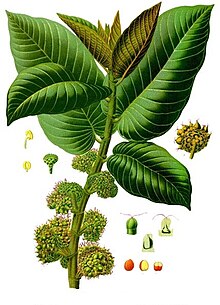| Castilla elastica | |
|---|---|

| |
| Scientific classification | |
| Kingdom: | Plantae |
| Clade: | Tracheophytes |
| Clade: | Angiosperms |
| Clade: | Eudicots |
| Clade: | Rosids |
| Order: | Rosales |
| Family: | Moraceae |
| Genus: | Castilla |
| Species: | C. elastica
|
| Binomial name | |
| Castilla elastica Cerv.
| |
| Synonyms | |
| |
Castilla elastica, the Panama rubber tree, is a tree native to the tropical areas of Mexico, Central America, and northern South America.[3] It was the principal source of latex among the Mesoamerican peoples in pre-Columbian times. The latex gathered from Castilla elastica was converted into usable rubber by mixing the latex with the juice of the morning glory species Ipomoea alba which, conveniently, is typically found in the wild as a vine climbing Castilla elastica. The rubber produced by this method found several uses, including most notably, the manufacture of balls for the Mesoamerican ballgame ōllamaliztli.
The Nahuatl word for rubber was ulli / olli, from which their word for the ballgame derived), and also their name for the ancient people they associated with the origin of the ballgame, the Olmecs (olmeca: "rubber people"). The Nahuatl word for the tree of Castilla elastica is olicuáhuitl;[4] in Spanish it is known as palo de hule.
- ^ Linares, J. & Condit, R. (2021). "Castilla elastica". IUCN Red List of Threatened Species. 2021: e.T150843489A175886925. Retrieved 14 March 2023.
- ^ "Castilla elastica Cerv. — the Plant List".
- ^ "Castilla elastica". Germplasm Resources Information Network. Agricultural Research Service, United States Department of Agriculture. Retrieved 2009-10-16.
- ^ "Castilla elastica" (PDF). Comisión Nacional para el Conocimiento y Uso de la Biodiversidad.
